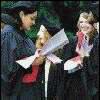|
Gladiator Guru Holds His ŽAll Hail' for Box Office Hit
York U. Roman Empire Expert Says Gladiator Captures the Times, But Throws Hollywood Myths to the Lions
TORONTO, May 11, 2000 -- York University history and classical studies professor Jonathan Edmondson says that the recently released movie Gladiator brilliantly captures the mood and look of the Roman arena with its excellent special effects, but it is laden with historical inaccuracies, perpetuating some of the classic Hollywood myths about the Roman era.
Likened by film critics to Spartacus and Ben Hur, Gladiator is set in the year AD 180, when the Roman Empire was at its peak. The ailing and aging Roman emperor Marcus Aurelius arouses the anger of his son Commodus, who discovers that his father's dying wish is to have the great Roman General Maximus be his successor. Commodus kills his father and orders the death of Maximus and his family. Maximus escapes, but is captured by slave-traders and sold to the gladiatorial trainer, Proximo. Maximus returns to Rome incognito to fight in the Amphitheatre in front of Emperor Commodus. He soon becomes the town's best gladiator, and confronts his arch rival in the movie's closing scene.
"Gladiator provides an excellent visual re-creation of the Flavian Amphitheatre," says Edmondson, who has taught graduate courses on Roman imperialism and Roman gladiators as part of his specialization in the history, culture and economy of the Roman Empire (including Roman Spain)."The movie accurately portrays the political tensions between the Roman emperor, the senate, the army and the plebs, the institution of slavery, the rapid changes in fortune that could occur in Roman society, and the living conditions of slaves."
Edmondson notes, however, that the movie suffers from the following historical inaccuracies and omissions:
The gladiatorial program was inaccurately portrayed. The normal program included beast-hunts in the morning, execution of criminals over lunch, gladiators in the afternoon. Edmondson says the use of tigers as part of the fight between the retired Gaul and Maximus is also very implausible, adding that wild beasts were used to execute criminals or for combats with specially trained beast-hunters.
The wide variety of gladiators -- Thracians, myrmillons, secutors, retiarii, essedarii, equites and others -- was inadequately depicted. And there was little note of the speciality training required to master the art.
The notion that so many valuable gladiators would have been wasted in such a small-town setting. "Sources show that pretty shoddy, tenth-rate gladiators were frequently used," says Edmondson. "The best were saved for games celebrating the imperial cult, which the local chief-priests were required to put on annually in the main cities of the provinces."
The thumbs up/thumbs down by the Emperor to signal that the gladiator could kill his defeated opponent and the salutation "Those who are about to die salute you." Edmondson says that salutation was, as far as we are aware, actually uttered just once -- by condemned criminals to the Emperor Claudius before they were slaughtered at a mass naval spectacle he was staging on Lake Fucinus, south of Rome.
The overlooking of much vivid historical source material on Commodus himself. "Contemporary texts Ů particularly that of the Roman senator and historian Cassius Dio who witnessed Commodus' exploits with great unease first hand Ů report that Commodus was a very good athlete, who loved to appear in the arena himself," says Edmondson. "In private, he occasionally killed men, and sometimes sliced off a nose, an ear and various Žother' parts. But in public, he never used real weapons and refrained from shedding human blood. Commodus also frequently performed as a beast-hunter, killing domestic animals and bears --100 on one occasion -- tigers, hippopotamuses and elephants. His love of the arena was so intense that it was eventually rumoured that his father was not Marcus Aurelius, but a gladiator who was his mother's lover."
It would have been absolutely impossible during this period that Maximus was an army commander, but not a senator. "All army commanders were appointed by the emperor from among the senators," says Edmondson. It was only later, in the third century, that this rule was increasingly overlooked."
The Amphitheatre was not called the Colosseum until Venerable Bede's time, around AD 700. It was known as the Flavian Amphitheatre or, simply, "the Amphitheatre".
Edmondson has written numerous books and articles on the Roman Empire including: "Dynamic arenas: gladiatorial presentations in the city of Rome and the construction of Roman society during the Early Empire," in W.J. Slater (ed.), Roman Theater and Society. Ann Arbor: University of Michigan, 1996; Dio: The Julio-Claudians. Selections from Books 58-63 of The Roman History of Cassius Dio (Translation with introduction and historical commentary) (LACTOR, 15). London: London Association of Classical Teachers, 1992; "The cultural politics of public spectacle in Rome and the Greek East, 167-166 BCE," in B. Bergmann & C. Kondoleon (ed.), The Art of Ancient Spectacle. Studies in the History of Art 56. Washington, D.C.: National Gallery of Art, 1999.
His teaching interests include Roman history, especially Roman imperialism, Roman spectacle, literature and culture in the age of Augustus and the self-image and later representation of Roman emperors such as Caligula, Claudius and Nero. Edmondson is currently conducting research on cultural interaction and cultural change in Roman Spain, the funerary monuments of Augusta Emerita (M»rida, Spain), local colonial society at Augusta Emerita, and gladiators in Roman society.
-30-
For more information or to arrange an interview, contact:
Prof. Jonathan Edmondson
Department of History
York University
(416) 736-2100, ext. 30417
e-mail: jedmond@yorku.ca
Ken Turriff
Media Relations
York University
(416) 736-2100, ext. 22086
e-mail: kturriff@yorku.ca
YU/054/00
|

![[to York's Home Page]](../../images/yorklogos.gif)
